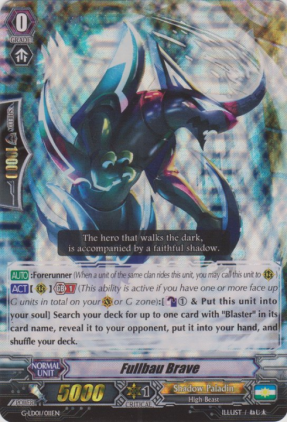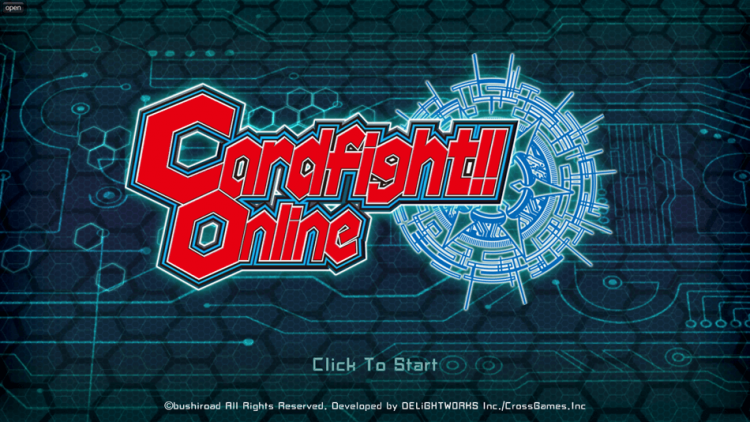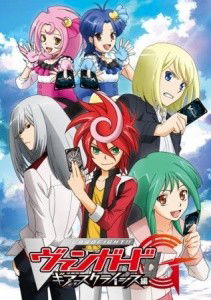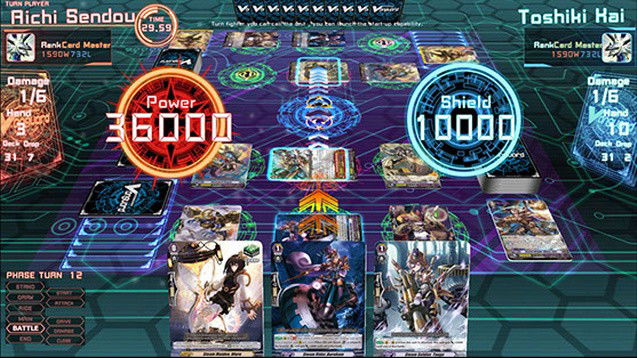Cardfight Online, the game that snuck into beta without me knowing, and based upon the popular Cardfight!! Vanguard collectable card game has had it’s first of hopefully many beta sessions back in February. Now that I’ve had some time to reflect upon the game and review the footage that I recorded during that period, I’m here to give my impressions of the game so far.
Title: Cardfight Online
Platform: Stream
Publisher: Bushiroad
Developer: DELiGHTWORKS Inc. / CrossGames.Inc
Genre: Collectable Card Game
Release Date: TBD 2016
Price: Free (Contains Microtransactions)
Disclosure: These are impressions of the BETA version of the game and do not represent the final product
So far, Cardfight Online looks to be fine mechanically. For those of you who have never played Cardfight!! Vanguard before, I’ll give you a quick breakdown of the game in general.

Game Overview
Cardfight!! Vanguard is a two player game in which 2 players will sit or stand at the opposite ends of a couple of playmats and do battle using a single Commander unit (Called a ‘Vanguard’), 2 support units that can do either damage or act as extra defence (Called ‘Rear Guards’) and 3 extra units that can increase the power level of the Vanguard or front Rear Guards (Called ‘Boost Units’). The objective of the battle is to get 6 cards into your opponents ‘damage zone’ by having bigger numbers than your opponent. You can gain bigger numbers through 2 methods: Using the Boost Units to add a specific amount of power to your attack, and the other is through one of the many additional mechanics like Legion, Stride or Breakride.

Card Breakdown
The breakdown of a Cardfight!! Vanguard card is complex but easy to understand. Cards are broken down into ‘Grades’ of 0, 1, 2, 3 & 4. This affects the Vanguard only as it’s like Pokemon where you can evolve the Commander to higher and higher levels; though your Vanguard’s level dictates what level Rear Guard cards you’re allowed to have on the front line with your Vanguard. Rear Guards cannot be of a higher level than your Vanguard.
Next piece, under the Grade, is the ability icon. You have 4 icons: Boost, Intercept, Twin Drive & Triple Drive. Grade 0 & 1 cards can boost any level card in the front row of the playmat. Grade 2 cards can use Intercept, a mechanic where a Grade 2 card on the front row can be sacrificed to help protect the Vanguard (As the Vanguard is the only card that takes damage that can lead to a loss), and the Grade 3 & 4 ‘Drive’ mechanics allow you to draw extra cards in a chance of getting ‘Triggers’, another set of special condition cards that can benefit the player and sometimes turn the tide of battle.
Next up, on the left hand side of the card is the ‘Guard Value’. Cards will have a Guard Value of 10’000, 5000, 0 (Or Complete Guard. See the Trigger card line up below.) or nothing at all. You can use these cards to protect your Vanguard or Rear Guard units during the ‘Guard Phase’ during the game. As the cards progress in Grades, the less defence they have. This is a trade off for access to more attack power and additional mechanics.
The next thing you’ll need to be aware of is the card mechanics text. This is where you’ll learn what the effects are for things like Counterblast (Using damage cards as a power to do additional things), Legion (Joining 2 cards together for an additional power boost), Stride (Using a Grade 4 card for 1 turn), and many other things that are complex and really need to be seen to be understood. There’s a lot to take note of here, so make sure you take the time to read and remember what you want to do before you do anything in the game.
Finally, you’ll notice a Sword with some numbers next to it, and next to that the number 1 next to a yellow Star. These are the attack power and damage each card can do. The attack number is the one that you want to make as big as possible. The bigger the attack number is, the harder it is for your opponent to defend against your attack and then you win the game! The yellow Star is nothing more than how much base damage the card does, which can change depending on ‘Triggers’. Obviously, the higher grade cards you use to attack, the bigger numbers you attack with.

Now the final thing I’ll be explaining card wise are the ‘Trigger’ cards. These are a set of 4 cards with specific effects. In addition to the effects listed below, you gain an additional 5000 attack points that you can give only once per Trigger card revealed during a ‘Drive check’ (See the phase explanation) to any of your front row Rear Guards or your Vanguard.
- Critical: An additional point of damage.
- Draw: Draw an extra card that goes right into your hand.
- Stand: Stand a previously used card to allow it to attack again
- Heal: Heals one damage from the damage zone (duh!)
The fifth card that you’ll see in the line up below is called a ‘Sentinel’. This is an ultimate blocking card that will stop all attack in that turn. For example, if an opponent was to attack my Vanguard for 31’000 attack and I didn’t have enough cards in hand or on field to stop the attack through normal Guarding, I can use this card to instantly nullify all of that attack, regardless of triggers and bonuses. However, the opponent can still add any Trigger card effects to any other card that has not attacked. A Sentinel card only works against 1 attack card, not all the attacks that turn.

Now I know that all of what is a lot to take in, however when it comes to Cardfight Online, you get maybe half of this information during it’s 4 tutorial sections when you first enter the game. With a game like Cardfight Online that has so many mechanics that are needed to be known in advance before you even begin the game itself, to only get half of the information that I have provided is one of a few minor flaws that need to be addressed from the Beta.
The Game Itself
The basics of Cardfight Online are simple: First to 6 damage loses. It’s a simple concept, but there’s the usual card game complexity that goes along with it. This complexity are known as ‘Phases’ and they are the staple of card games since their inception… I blame Magic The Gathering. Anyway, the phases used in Cardfight Online are:
- Stand Phase: During your stand phase, turn all of your units that are rest Rest (horizontal) to stand Stand (vertical), once each, unless they are prevented from doing so by an ability.
- Draw Phase: The draw phase has two steps, which must be done in this order, and only once each turn.
– Draw a card from the top of your deck without revealing it.
– G-Assist: By scarificing 2 cards from the ‘G-Zone’ and 2 cards from your hand, you can get a card that is one level higher than your current Vanguard. (Unless your Vanguard is level 3, then it’s not allowed) This prevents you from getting ‘Grade Stuck’, which was a common problem in early version of the game. - Ride Phase: The ride phase has two steps, which must be done in this order, and only once each turn.
– Ride: You may normal ride only once in this step. Choose a card from your hand that is one grade greater than, or equal to, your current Vanguard, and place it on top of your current Vanguard. Like Evolving a Pokemon in the Pokemon TCG.
– Stride: You may normal Stride only once in this step. If both you and your opponent have a grade 3 or greater vanguard, you may discard cards from your hand with the sum of their grades being 3 or more, choose a G unit that is face up from your G zone, and Stride it onto your vanguard circle in the same [Stand] or [Rest] state as your vanguards were prior to Striding. All of your vanguards that were previously on your vanguard circle become a heart card, then you choose one of the heart cards, and the G unit that was placed only gets the original power and card name of that heart card. - Main Phase: During the main phase, you prepare for the battle by playing units and using abilities.
– You may normal call any number of units from your hand to your rear-guard circles, only once each. The cards to be normal called must have the same or lower grade that your vanguard (or your Legion Leader in such case).
– You may call a unit on top of one of your rear-guards that already is on the field. In that case, the previous unit that was on that circle is put into your drop zone.
– You may move your rear-guards between the front and back row of the same column where they are. Two rear-guards in the same column may be moved between them. When a unit is moved to a rear-guard circle from another rear-guard circle, it remains in the same [Stand] or [Rest] state as in the previous circle.
– Use [ACT] abilities; the [ACT] abilities of your cards only can be used during your own main phase. This can be done any number of times, as long as you can pay the cost, unless one of those [ACT] abilities has [1/Turn] on it. - Battle Phase
– Start Step: Start step is where you choose whether to attack or not.
– Attack Step: Attack step is where you may choose with which unit attack first. Abilities such as boosting can be used at this point to increase the overall attack power of the attacking unit.
– Guard Step: Guard step is where your opponent may use guardians to prevent the attack hit. This is achieved via a combination of using cards from your hand or any Grade 2 cards on the field to create a guard value higher than your opponent’s attack value. The other option is using a Sentinel card if you have one.
– Drive Step: If the attacking unit is a Vanguard, you check for additional effects during the attack, known as “drive check”. “Drive” is refered as the amount of drive checks that you must perform in this step. To drive check, put the top card of your deck into your trigger zone face up. If you get any of the ‘Triggers’ (Critical, Heal, Draw or Stand) then you resolve the effects. (See Trigger cards above)
– Damage Step: Damage step is to confirm whether the attack to the ‘unit being attacked” will hit, as well as the damage to be dealt. Any damage dealt is show by turn 1 card at a time, face up, from your deck to the damage zone. Any Triggers revealed in this way also take effect.
– Close Step: Close step is where all effects that happen at the end of a battle, or at the beginning of close step, are activated. After resolving, the battle arrived to its end. - End Phase: All effects with at the end of turn or at the beginning of your end phase, are activated. After resolving, declare the end of your turn, then the next player’s turn starts, beginning with his or her stand phase.
And that’s pretty much it. That’s how you play Cardfight Online in one very big nutshell. Basically you repeat the Phases over and over again until 6 damage has been done to one player, someone runs out of cards, or some cards allow an instant win condition. The good thing about doing all this in an online environment like Cardfight Online is that all the tiny details are done automatically. You don’t need to manually calculate the attack power vs the guard power, the game notifies you about all that on screen. Plus there’s a handy little Phase Guide on the screen at all times that changes when you move into another phase.
Seeing as this is a BETA build of the game, Cardfight Online does it’s job well. It simulates the experience of playing Cardfight!! Vanguard in every single way. Aside from a few balancing issues with the available decks, and the fact that Cardfight Online is extremely behind on the real game meta, I say it’s going to do quite well in the same way that other card games like Magic The Gathering and Pokemon TCG Online have already done. Again, because it was a BETA, there were some features that were unavailable during this testing phase. I would like to have seen what the pack opening was like, what it was like to change the meta of the decks with more cards, and the other parts of the card game that make things exciting. But as this was more of a test of the actual gaming system, it get’s a pass at this time.
If there was one thing I would “demand” that get’s added to the final build, it’s that there should be some sort of single player component or some AI that you can play against to test your decks or just grind a bit of gold away from the more hardcore online players. While online competiton is the end goal for a game like Cardfight Online, something more single player would be a good training exercise or testing method for players who might feel a bit intimidated by the online scene.
Overall the game looks good, the tutorials need a bit of work for those unfamiliar with the game. (A few games I played against Clinton online ended with him getting ‘Grade stuck’ and forgetting about G-Assist; which lead to me slaughtering him with my more advanced knowledge of the game in general) I’d also like to see the rate at which Triggers appeared during the Drive Check phase be reduced as I’ve played games where I or my opponent would pull Heal Triggers at the moment we needed them the most, which at times prolonged the game more than usual. I think once these are addressed that the game will flow a lot better and people will join in droves to play Cardfight Online.
Make sure to keep an eye out here at The Outerhaven for a full review once Cardfight Online goes live later in 2016.




